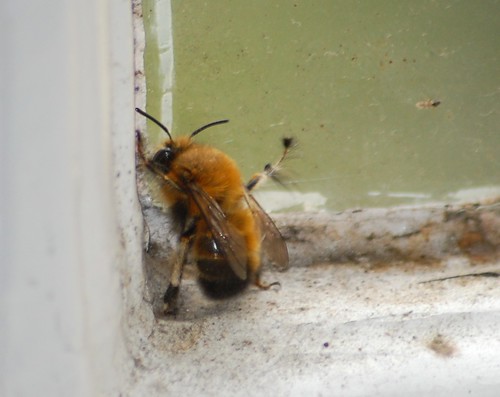Way back at Christmas 2013, I decided on a couple of wildlife challenges for the forthcoming year. Being a pan-species lister interested in the amazing variety of wildlife to be found in gardens (check out the Garden Bioblitz!), the obvious starting point was Andy Musgrove's 1000 species in a 1km square challenge. As the name suggests, this was an attempt to find one thousand different wild species (plants, fungi, invertebrates - even the tiny handful of vertebrates that call Britain home can contribute) - in a single square kilometre. As a further challenge, I wanted to see if I could reach the magic four figures just in my own rented house and garden - 971 square metres of landlord-controlled standard suburbanity in rural Oxfordshire.
 |
| Species #273: The pseudoscorpion Chernes cimicoides from January |
Fast-forward a year to now, and that's pretty much it for 2014. As I write, it's the evening of the 20th December, and the newly-decorated Christmas tree is twinkling gently in the corner of the room. The year panned out a bit differently to how I envisioned it back in 2013: primarily, I spent a lot less time at home! Partly because work was a lot busier than planned: more importantly, I met a girl and so began spending a lot of my spare time in Bath.
But the species list continued to grow whenever I was back in Oxfordshire. The warm summer meant the moth trap was particularly productive - not just moths, but plenty of beetles, flies, woodlice and more. The drought wasn't entirely helpful though - it was noticeable how few invertebrates were to be found beneath rocks and logs, having dispersed to find damper microhabitats.
The year's final wander around my local patch was Thursday, and having gone back to my parents for Christmas, it's time to tot up the final scores...
 |
| December Moth on 15/12/2014 - one of the last species of the year, but what number was it? |
The most ambitious first: the garden list fell short in the end, with 756 species. This actually ended up lower than last year (796 species identified in 2013), mainly because I did a lot less summer moth-trapping in 2014. It was enough to push the all-time garden list into four figures though, ending on 1185, so half a point there...
For my local 1km square as a whole, the target was reached - species number 1000 for the year (the Batman hoverfly Myathropa florea) turned up in mid-August, and although effort slackened somewhat in the autumn, a few days' work with the microscope dealt with most of the specimen backlog. The final count: 1,422 species!
Unsurprisingly, insects dominated the final count - 830 species were recorded in total, with a respectable showing for plants (295 species). Breaking down the insect score, moths were the single largest contributor (343 species), followed by the beetles (173 species, including the last additions to the list - two individuals of the dung beetle Aphodius obliteratus which turned up in the moth trap on the 19th December).
Unsurprisingly, insects dominated the final count - 830 species were recorded in total, with a respectable showing for plants (295 species). Breaking down the insect score, moths were the single largest contributor (343 species), followed by the beetles (173 species, including the last additions to the list - two individuals of the dung beetle Aphodius obliteratus which turned up in the moth trap on the 19th December).
 |
| Breakdown of the species groups found in my Sutton Courtenay 1km square during 2014 |
 |
| Breakdown of the insects in my 1km square |
I've been recording as I go along, so it's easy to see the area covered. My two main walks - round the lakes in the centre and up to the river and across the weirs - show up well, with a few different excursions. The only real gaps are the housing estates in the north-east and south-west, and the rank flood meadows in the north-east.
 |
| Recorded squares, 2014 |
Taxonomically, what's been really striking is how much more there is to find! The 1422 species I found includes barely any mosses (1100-ish potential species), lichens (1300 species), flies (8500 species), spiders (650 species), or hymenoptera other than bumblebees (8000 species), not because they're not there, but purely because of my taxonomic limitations!
But I won't get the chance to find out what the upper limit for this particular square is. In January, I'm moving to Malvern in Worcestershire, on the edge of the Malvern Hills AONB. Lots of exploring to do!






































